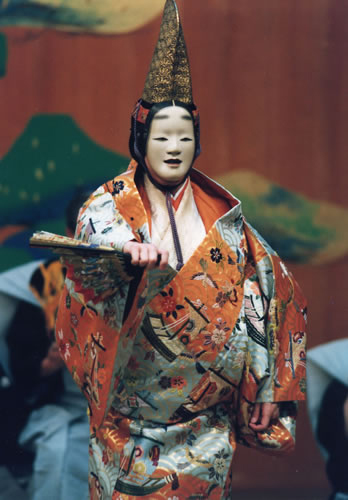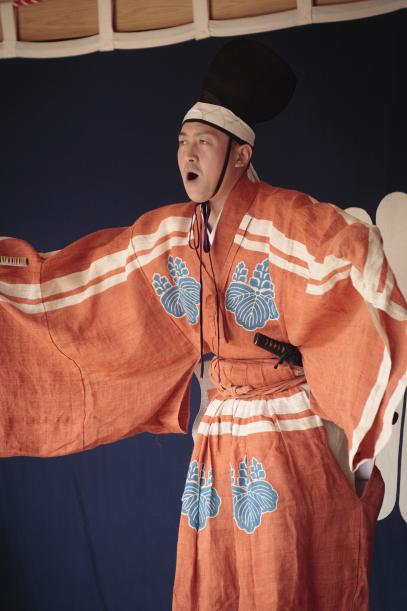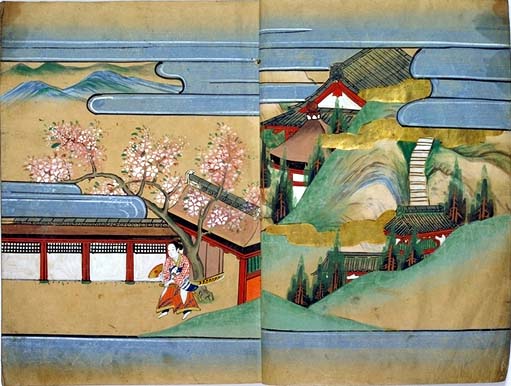Minamoto no Yoshitsune
Historical Periods in Japan
Heian 794 - 1192
Kamakura 1192 - 1336
Muromachi 1336 - 1573
Azura-Muromachi 1568 - 1600
Tokugawa 1600 - 1868
Meiji 1868 - 1912
Yoshitsune lived at the very end of the Heian period;
his brother's ascendancy to Shogun marked the beginning
of the Kamakura period.
It was in the Muromachi period that much of the Yoshitsune
literature was written:
- 'Gunki monogatari' ('war tales')
- are stories based on
real episodes from Japanese history. However,
they are often modified significantly for
dramatic purposes. Although early examples,
such as the 'Heiki Monogatari', portray Yoshitsune
as an active warrior, the later tales emphasize
his tragic nature and cultural sophistication.
'Gikeiki' is a collection of
stories about the youth and fugitive years of
Yoshitsune, written in Muromachi circa 1400
- Noh dramas
-
combine music and singing and dancing to tell
a story.
14 of the 240 Noh dramas in the current
repertoire, such as 'Ataka' and 'Funa Benkei',
tell stories about Yoshitsune
and his followers.
Most Noh plays were written in the Muromachi period.

- 'Kouwaka no mai' dances
-
told stories with a combination
of music and motion, similar perhaps to the
Noh dramas. They flourished in the late
Muromachi and early Tokugawa periods, but
disappeared before the Meiji restoration.
14 of the 44 surviving texts are based on Yoshitsune.

- 'Otogi zoushi' and 'chusei shousetsu'
-
are illustrated
stories, written anonymously and aimed at
a juvenile market. Most were written
in the Muromachi and early Edo periods.
There are 16 'otogi zoushi' about heroes,
and Yoshitsune appears in 8 of them.

Even though in real life, Yoshitsune became famous
through his genius in battle,
in Japanese literature, he appears as a very
different person.
Authors of the Muromachi period looked back to the Heian
times for inspiration. Their ideal men are not rough warriors
striding across the battlefield, but sensitive poets who
mourn the transience of life.
In most of the Japanese literature,
Yoshitsune does things like
- play his flute
- write poetry
- have love affairs
- watch the moon
- muse upon the fleeting nature of man's life
It is his surrounding characters --
Benkei the monk, Shizuka his mistress --
who carry the action.
For example,
- In the Noh play 'Funa Benkei', Yoshitsune and his
party are crossing the sea in a boat when the
angry spirit of Taira no Tomomori appears.
Tomomori was one of the leaders of the Taira
clan whom Yoshitsune's army defeated years earlier.
Tomomori's spirit tries to drag Yoshitsune to the
bottom of the sea. Benkei saves Yoshitsune by
praying to the Buddhist deities.
- In the Noh play 'Ataka', Yoshitsune and his followers,
fleeing the forces of his brother, are stopped at
a checkpoint. Benkei does all talking while Yoshitsune
is disguised as a baggage carrier. The officer of the barrier
grows suspicious of them, so Benkei beats Yoshitsune
to prove that the boy is nothing but a lowly servant.
Apparently,
many Japanese people in the past --
and perhaps today? --
admire tragic figures:
men and women who suffer an unhappy fate,
who are aware of their destiny yet powerless
to change it.
The pathos of these figures has a special
term in Japanese:
mono no aware.
Yoshitsune, due to his noble birth
quick rise to fame, long flight from the hostile
forces and early death,
provides a perfect frame
into which Japanese authors can
place their own invented stories.
References:
- "Yoshitsune: A Fifteenth-century Japanese Chronicle",
Helen Craig McCullough, Stanford University Press, 1966
- "Kouwaka: Ballad Dramas of Japan's Heroic Age",
James T. Araki,
Journal of the American Oriental Society, vol 82, p. 545 (1962)
- Exhibition of otogi zoshi from the Kyoto University Library,
http://edb.kulib.kyoto-u.ac.jp/exhibit-e/otogi/cover/index.html
- Examples of otogi zoshi from the Keio University Zumi project
"http://dbs.humi.keio.ac.jp/naraehon/about/index-e.html"
- 'Funa Benkei' Noh drama description and pictures,
http://www.the-noh.com/en/plays/data/program_003.html
- 'Ataka' Noh drama description and pictures,
http://www.the-noh.com/en/plays/data/program_009.html





